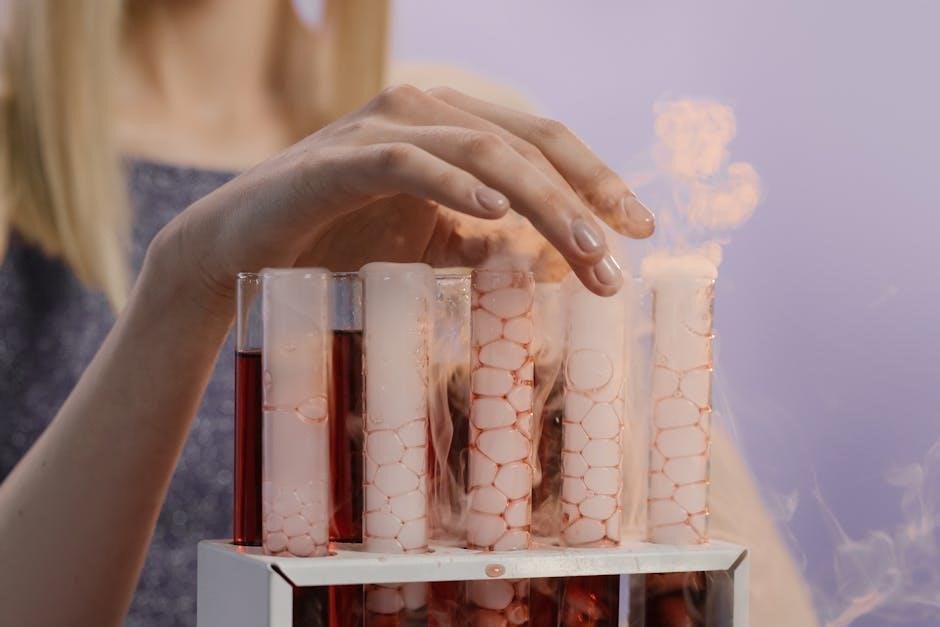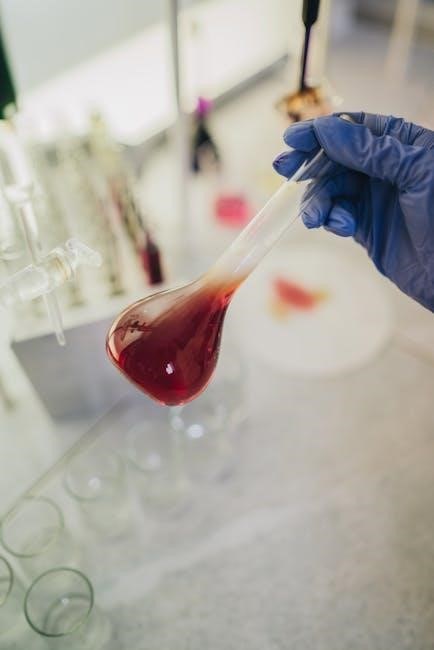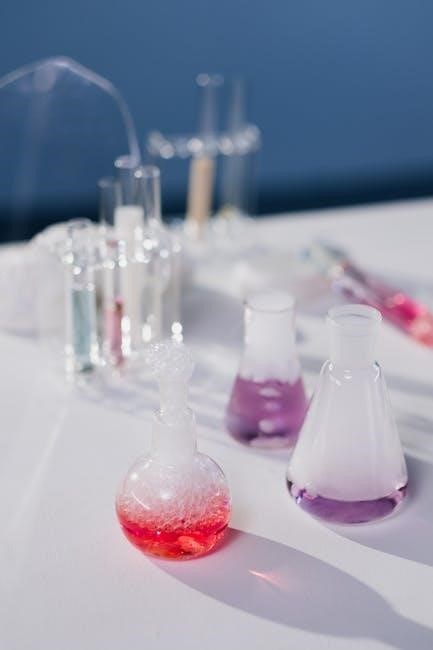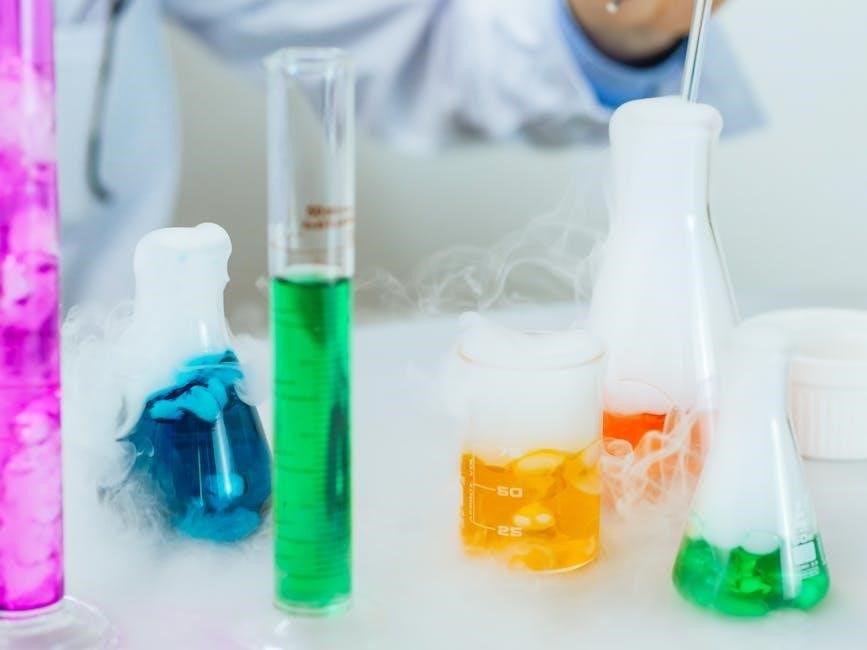The iodine clock reaction is a classic chemistry experiment demonstrating chemical kinetics. It involves the reaction of iodine species with redox reagents‚ producing a visible color change with starch as an indicator.
1.1. What is the Iodine Clock Reaction?
The iodine clock reaction is a chemical experiment where iodine species react with redox reagents‚ producing a visible color change when starch is added as an indicator. Two colorless solutions are mixed‚ and after a delay‚ the mixture turns dark blue due to the formation of triiodide ions (I₃⁻)‚ which stain the starch. This reaction demonstrates chemical kinetics‚ as the time taken for the color change depends on reaction rates influenced by concentration‚ temperature‚ and catalysts. It is widely used in education to illustrate reaction dynamics and the factors affecting them.
1.2. Historical Background and Discovery
The iodine clock reaction is a classical chemical demonstration with a rich historical background. Discovered in the mid-20th century‚ it was developed to illustrate chemical kinetics through a visible color change. Initially used in academic settings‚ the experiment gained popularity for its simplicity and effectiveness in teaching reaction rates. The reaction involves iodine species and redox reagents‚ with starch acting as an indicator to show the formation of triiodide ions. Its discovery revolutionized hands-on chemistry education‚ making complex concepts accessible to students. Today‚ it remains a cornerstone of chemistry curricula worldwide.
1.3. Key Observations and Phenomena
The iodine clock reaction exhibits distinct phenomena‚ including a sudden color change from colorless to deep blue‚ signaling the formation of triiodide ions when starch is present. Initially‚ the mixture remains clear as reactants slowly decompose. Once a threshold is reached‚ the solution rapidly changes color‚ indicating the reaction’s endpoint. This delayed response demonstrates the concept of reaction kinetics‚ where rates depend on concentrations and catalysts. The color change is both dramatic and educational‚ making it an ideal demonstration for teaching chemical principles in an engaging manner.

Chemical Principles Behind the Reaction
The iodine clock reaction illustrates oxidation-reduction processes‚ where iodine species react with redox reagents. The reaction’s visible endpoint is marked by a color change‚ indicating the formation of the triiodide-starch complex.
2.1. Stoichiometry of the Iodine Clock Reaction
The iodine clock reaction involves precise molar ratios of reactants‚ including hydrogen peroxide (H₂O₂)‚ sulfuric acid (H₂SO₄)‚ potassium iodide (KI)‚ and sodium thiosulfate (Na₂S₂O₃). The reaction proceeds through oxidation-reduction reactions‚ where iodine is both oxidized and reduced. The stoichiometric balance ensures a delayed reaction‚ with iodine species reacting in a timed sequence. The key steps involve the formation of iodine (I₂)‚ which reacts with excess iodide ions to form triiodide (I₃⁻). The reaction’s endpoint is marked by the appearance of a dark blue color due to the triiodide-starch complex. This stoichiometric control allows for consistent and measurable reaction timing‚ making it an ideal demonstration of chemical kinetics.
2.2. Role of Catalysts in the Reaction
Catalysts play a crucial role in the iodine clock reaction by accelerating the redox processes without being consumed. Common catalysts include hydrogen peroxide (H₂O₂) and sulfuric acid (H₂SO₄)‚ which facilitate the oxidation of iodide ions (I⁻) to iodine (I₂). These catalysts lower the activation energy‚ enabling the reaction to proceed at a measurable rate. The choice and concentration of catalysts significantly influence the reaction timing‚ making them essential for controlling the experiment’s duration. By varying catalysts‚ the reaction’s speed can be adjusted‚ demonstrating their impact on chemical kinetics and reaction dynamics.

2.3. The Role of Starch as an Indicator
Starch acts as a visual indicator in the iodine clock reaction by forming a blue-black complex with iodine. This color change signifies the endpoint of the reaction. Starch is essential for observing the sudden appearance of iodine‚ as it amplifies the visibility of the reaction’s progress. The blue-black coloration indicates that free iodine is present in the solution‚ making it easier to measure reaction rates and timing. Without starch‚ the subtle color changes of iodine would be difficult to detect‚ making the experiment less effective for demonstration and analysis. Its role is critical for clear‚ observable results.

Materials and Preparation
The experiment requires hydrogen peroxide‚ vitamin C‚ starch‚ sulfuric acid‚ and distilled water. Essential equipment includes beakers‚ measuring cylinders‚ and a thermometer for accurate preparation; Safety goggles are mandatory.
3.1. List of Required Chemicals and Equipment
The iodine clock reaction requires hydrogen peroxide (H2O2)‚ vitamin C (ascorbic acid)‚ potassium iodide (KI)‚ sulfuric acid (H2SO4)‚ and starch as an indicator. Essential equipment includes beakers‚ measuring cylinders‚ glass rods‚ a stopwatch‚ and safety goggles. Distilled water is needed for solution preparation. Optional items like thermometers and LED timers enhance precision. All chemicals should be handled with care‚ and safety protocols must be followed strictly to avoid accidents.
3.2. Preparation of Solutions (Hydrogen Peroxide‚ Vitamin C‚ etc.)
Prepare a hydrogen peroxide solution by diluting it with distilled water to the desired concentration. Dissolve vitamin C (ascorbic acid) in water to create a reducing agent solution. Potassium iodide is dissolved in water to provide iodine ions. Starch is dissolved in hot water to form a color-changing indicator. Sulfuric acid is added to hydrogen peroxide to create an acidic environment. All solutions should be mixed in the correct order and handled with safety precautions to ensure accurate and safe reactions.
3.3. Safety Precautions and Lab Setup
Conduct the experiment in a well-ventilated lab with protective gear: gloves‚ goggles‚ and lab coats. Handle strong acids and oxidizing agents like hydrogen peroxide with care to avoid skin contact. Ensure the workspace is clear and free from flammable materials. Use glassware and equipment resistant to chemical corrosion. Prepare spill kits and eyewash stations nearby. Maintain a safe distance from open flames or sparks. Follow proper disposal protocols for chemical waste. Supervise students during the setup and reaction observation. Ensure all participants understand emergency procedures before starting the experiment.
Step-by-Step Procedure
Prepare hydrogen peroxide and sulfuric acid solution. Mix with iodide and catalyst. Add starch indicator to observe color change. Time the reaction until blue appears.
4.1. Mixing the Reactants
4.2. Observing the Color Change
After mixing the reactants‚ observe the solution closely for any visible changes. Initially‚ the solution remains clear or pale yellow. Over time‚ it gradually turns amber as iodine (I₂) forms. Suddenly‚ the solution changes to a deep blue color due to the starch-iodine complex. This color change indicates the endpoint of the reaction. Record the exact time taken for the transformation. The delay before the color change occurs is crucial for measuring the reaction rate. Ensure continuous observation to capture the precise moment of the color shift‚ as it signifies the completion of the iodine clock reaction.
4.3. Recording Time and Results
Accurately record the time taken for the solution to change color using a stopwatch or timer. Note the exact moment the deep blue color appears‚ as this marks the reaction’s endpoint. Document the time intervals and any variations observed during repeated trials. Maintain a detailed record of all observations‚ including the concentration of reactants‚ temperature‚ and catalysts used. Organize the data in a table for clarity. This documentation is essential for analyzing how different factors influence the reaction rate. Consistent and precise recording ensures reliable results for further analysis and comparison.

Factors Affecting the Reaction Rate
The iodine clock reaction rate is influenced by multiple factors‚ including concentration‚ temperature‚ and catalysts. These variables determine the speed and timing of the reaction.
5.1. Effect of Concentration on Reaction Time
The concentration of reactants significantly impacts the reaction time in the iodine clock experiment. Higher concentrations of hydrogen peroxide or iodide ions increase the reaction rate due to more frequent collisions between particles. This accelerated rate shortens the time before the solution turns dark blue‚ as the iodine-starch complex forms more quickly. The relationship between concentration and reaction time provides a clear demonstration of chemical kinetics principles‚ allowing students to observe how altering reactant concentrations affects the reaction’s progression and timing.
5.2. Influence of Temperature on the Reaction
Temperature significantly influences the iodine clock reaction‚ with higher temperatures accelerating the reaction rate. Increased thermal energy enhances molecular motion‚ leading to more frequent and energetic collisions between reactants. This reduces the time before the solution turns dark blue‚ as iodine forms and binds with starch faster. Conversely‚ lower temperatures slow the reaction by reducing particle kinetic energy and collision frequency. This temperature-dependent behavior aligns with kinetic theory‚ offering a practical demonstration of how environmental conditions affect chemical reactions. The experiment vividly illustrates the role of temperature in controlling reaction dynamics.
5.3. Role of Catalysts in Accelerating the Reaction
Catalysts play a crucial role in speeding up the iodine clock reaction by lowering the activation energy. Substances like hydrogen peroxide or sulfuric acid accelerate the oxidation of iodide ions‚ initiating the reaction faster. Catalysts increase the reaction rate without being consumed‚ allowing the iodine-starch complex to form more quickly. This reduction in activation energy leads to a shorter time before the solution changes color. The use of catalysts demonstrates how reaction rates can be controlled and highlights their importance in chemical processes‚ making them a key variable in studying kinetics through this experiment.

Safety Considerations and Handling
Wear protective gloves‚ goggles‚ and lab coats. Ensure proper ventilation to avoid inhaling chemical fumes. Handle acids and iodine solutions with care to prevent skin contact.
6.1. Proper Handling of Chemicals
When conducting the iodine clock reaction‚ always handle chemicals with care. Wear protective gloves‚ goggles‚ and a lab coat to prevent skin and eye contact. Ensure proper ventilation to avoid inhaling fumes from hydrogen peroxide or sulfuric acid. Use tongs or glass rods to handle hot or reactive substances. Store all chemicals in labeled‚ sealed containers and keep them away from direct sunlight. Dispose of waste according to standard laboratory protocols to minimize environmental impact. Never mix chemicals without prior knowledge of their reactivity‚ and follow the recommended dilution ratios to maintain safety.
6.2. Disposal of Chemical Waste
Proper disposal of chemical waste is crucial in the iodine clock reaction experiment. Separate neutralized and non-neutralized waste‚ using labeled containers to prevent cross-contamination. Acidic or basic solutions may require neutralization before disposal. Never pour chemicals down drains‚ as they can harm the environment. Store waste in sealed‚ appropriately labeled containers and consult local regulations for disposal guidelines. Ensure all disposable materials‚ such as gloves and paper towels‚ are collected and treated as hazardous waste. Always handle waste with protective equipment and delegate disposal to qualified professionals when possible to maintain safety and compliance with environmental standards.
6.3. Emergency Procedures
In case of accidents during the iodine clock reaction experiment‚ immediate action is required. If chemicals come into contact with skin or eyes‚ rinse thoroughly with water and seek medical attention. Spills should be contained using absorbent materials‚ and the area ventilated. Ingestion of any chemicals necessitates calling emergency services. Keep a first aid kit and fire extinguisher nearby. Wear protective gear‚ including gloves and goggles‚ to minimize exposure. Ensure all participants are trained in emergency protocols to handle unexpected incidents safely and effectively‚ preventing potential harm to individuals and the environment.

Educational Applications
The iodine clock reaction is a valuable educational tool for teaching chemical kinetics‚ demonstrating reaction rates‚ and encouraging STEM engagement through interactive‚ visually engaging experiments.
7.1. Teaching Chemical Kinetics
The iodine clock reaction is an engaging tool for teaching chemical kinetics‚ allowing students to observe and measure reaction rates. The experiment demonstrates how factors such as concentration‚ temperature‚ and catalysts influence the speed of reactions. By timing the color change‚ students can collect data to analyze reaction kinetics. This hands-on approach helps students visualize complex concepts like rate laws and reaction mechanisms. The clear visual indicator (starch-iodine complex) makes it easier for learners to track changes and understand the principles of chemical reactions in real-time.
7.2. Demonstrating Reaction Rates
The iodine clock reaction effectively demonstrates reaction rates through a dramatic color change. Students observe how varying concentrations of reactants or the presence of catalysts alter the time taken for the reaction to occur. By measuring the delay before the solution turns blue‚ learners can quantify how different factors influence reaction speed. This visual demonstration makes abstract concepts like rate constants and activation energy more tangible; The experiment aligns with curriculum requirements‚ providing a practical and engaging way to explore chemical kinetics and reaction dynamics.
7.3. Encouraging STEM Education
The iodine clock reaction serves as an engaging tool to promote STEM education; It fosters critical thinking and hands-on learning‚ encouraging students to explore scientific principles. By observing the reaction’s color change‚ learners gain insights into chemical kinetics and reaction rates. This experiment aligns with curriculum standards‚ providing a practical approach to understanding complex concepts. It also inspires curiosity and teamwork‚ essential skills in STEM fields. The visual and dynamic nature of the reaction makes it an effective way to spark interest in chemistry and related disciplines among students of all ages.

Variations of the Experiment
The iodine clock reaction can be modified using different catalysts‚ indicators‚ or reaction conditions‚ offering diverse ways to explore chemical kinetics and reaction mechanisms creatively.
8.1. Using Different Catalysts
Experimenting with various catalysts‚ such as vitamin C or hydrogen peroxide‚ can significantly alter the reaction dynamics. These catalysts accelerate the oxidation of iodide ions‚ reducing the delay before the color change. By comparing different catalysts‚ students can observe how reaction rates vary‚ providing insights into catalytic mechanisms. This variation allows for a deeper exploration of chemical kinetics and reaction pathways. It also encourages creative problem-solving and STEM-based learning experiences‚ making the experiment more engaging and educational.
8.2. Experimenting with Various Indicators
Exploring different indicators‚ such as methyl orange or bromothymol blue‚ offers insights into how these substances interact with iodine. Starch‚ commonly used‚ produces a blue-black color when iodine is present. However‚ other indicators may react differently‚ providing varied visual cues. This variation allows students to study how indicators respond to iodine and understand their chemical properties. It also demonstrates the importance of indicator specificity in chemical reactions‚ enhancing the educational value of the experiment and encouraging hands-on learning in chemistry. This approach fosters creativity and critical thinking in STEM education.
8.3. Modifying Reaction Conditions
Modifying reaction conditions‚ such as concentration‚ temperature‚ or catalysts‚ provides insights into how these variables influence the iodine clock reaction. Increasing the concentration of hydrogen peroxide or iodide ions can shorten the reaction time‚ while lower concentrations delay the color change. Temperature also plays a significant role‚ with higher temperatures accelerating the reaction. Introducing different catalysts‚ such as vitamin C or sodium thiosulfate‚ can alter the reaction kinetics. These variations allow for a deeper understanding of chemical principles and provide opportunities to study reaction rates and mechanisms in a controlled environment‚ making the experiment versatile for educational purposes.

The iodine clock reaction effectively demonstrates chemical kinetics‚ offering valuable insights into reaction rates and mechanisms. Its simplicity and educational potential make it a cornerstone in STEM education‚ inspiring further explorations and adaptations to enhance learning experiences.
9.1. Summary of Key Findings
The iodine clock reaction experiment demonstrates the principles of chemical kinetics through a visually striking color change. The reaction involves the interaction of iodine species with redox reagents‚ with starch acting as an indicator to reveal the formation of iodine. Key findings include the significant impact of concentration‚ temperature‚ and catalysts on reaction rates. The experiment provides clear evidence of how these variables can accelerate or delay the reaction‚ offering practical insights into kinetic mechanisms. Its simplicity and educational value make it an effective tool for teaching chemical principles and encouraging scientific inquiry in STEM education.
9.2. Potential Extensions of the Experiment
The iodine clock reaction offers opportunities for further exploration‚ such as investigating the effects of different catalysts or varying the concentrations of reactants. Researchers could also experiment with alternative indicators to observe distinct color changes. Additionally‚ studying the reaction under varying pH conditions or introducing environmental factors like light exposure could provide deeper insights. Another extension could involve quantitative analysis‚ such as measuring the exact concentration of iodine formed over time. These modifications can enhance the experiment’s educational value and encourage advanced scientific inquiry‚ making it a versatile tool for both students and researchers.

9.3. Importance in Chemical Education
The iodine clock reaction is a valuable tool in chemical education‚ providing a hands-on approach to teaching reaction kinetics and the scientific method. It simplifies complex concepts like catalysis and reaction rates‚ making them accessible to students. The experiment aligns with STEM education goals by fostering curiosity‚ critical thinking‚ and practical skills. Its visual appeal‚ with dramatic color changes‚ captivates learners and reinforces theoretical knowledge. This experiment not only builds foundational understanding but also inspires further exploration in chemistry‚ making it a cornerstone of educational laboratory activities.